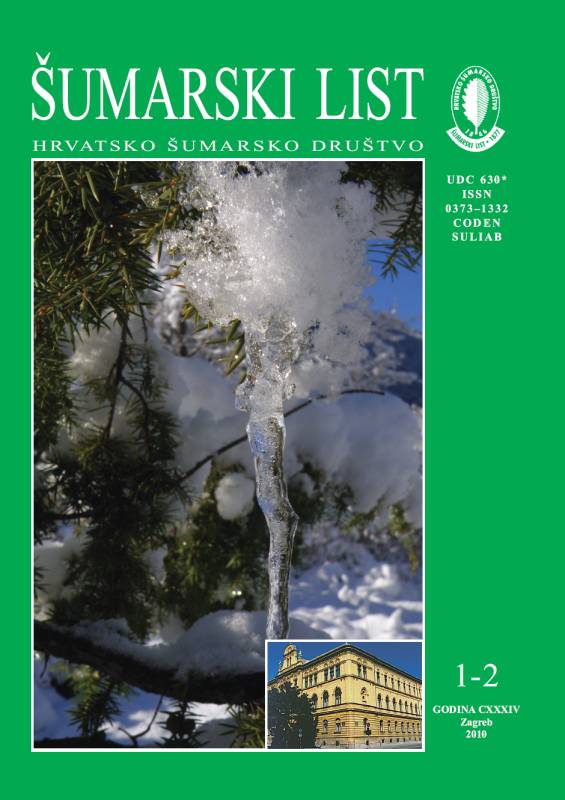
broj: 1-2/2010
pdf (9,0 MB) |
|
||||||||||||||
| RIJEČ GLAVNOGA UREDNIKA | ||
| Branimir Prpić | ||
| ON THE REGENERATION FINAL FELLING IN EVEN-AGED FORESTS pdf HR EN | 2 | |
| In “Šumarski list” I have already written on final felling in even-aged forests. Croatian forests considerablydiffer in quality from most European forests by their natural composition, which is similar to virgin forests fromwhich they originate. However, most people are outraged when they discover an area upon which we have carried out final felling. To myself a mature forest is by far more beautiful than the “disaster” resulting from our expert operation named forest regeneration. The proud tall trees that decorated the landscape suddenlydisappeared; we are irritated by their remnants, the stumps, cut off crown tops, furrowed soil, and skidder traces. To justify this procedure, let me now explain to non-foresters the reason for the such “disasters”. Following afinal cut, among the lush grass the expert eye of a forester will notice young plants quickly appearing from theseeds of the cut trees, freed from their shade. A young forest is born. With silvicultural care, it will soon soothe thewounds caused by the cut. A forest cannot be regenerated without pain. Left to nature, it first grows old, and thendecays. Depending on the species, dead trees on the ground will decay between twenty (beech) and eighty (fir)years. The regeneration starts during the decay, but it develops slowly and lasts more than half of the life of our naturally managed forest. The “disaster” would thus lasts for about fifty years; thanks to the forestry science, it takesonly about ten years. The procedure named regeneration felling consists of several cuts aimed at achieving future young trees of genetically best quality, with maintaining the existing forest association. Several tree species are here considered.Their regeneration and the achievement of mixture ratio require great experience and expert skill. Sustainable management, the axiom established in 1991 in Rio de Janeiro is taken into consideration. The most complex plant formation in the continental part of the world, forest with its perfection can be a model for the survival oftechnocoenosis. In order to cause the least possible public irritation, before determining the area for final felling we shouldkeep to the FSC Certificate and invite the local authorities, schools, green-peace associations and hikers to inform them on the procedures. We should show them the forest areas that have been successfully regenerated. Inthis way we can prevent the protests of those who regard final felling as devastation and even destruction of forest. Even some mycologists that regard final regeneration cut as ecocide show such ignorance. Professor Emeritus Branimir Prpić, Ph.D. | ||
| IZVORNI ZNANSTVENI ČLANCI | ||
| Idžojtić, M., M. Zebec, I. Poljak | UDK 630* 271 (001) | |
| Revitalisation of the Lisičine Arboretum pdf HR EN | 5 | |
| Trinajstić, Ivo | UDK 630* 164 + 188 (001) | |
| Chorological and Phytosociological Characteristics of Quercus Coccifera L. in Croatia pdf HR EN | 19 | |
| Pandža, Marija | UDK 630* 17 (001) | |
| The Flora of the Papuk Nature Park (Slavonia, Croatia) pdf HR EN | 25 | |
| Štimac, Milan | UDK 630* 222 + 242 (001) | |
| Impact of Forest Tending on Structural Characteristics of Coppices in Lika pdf HR EN | 45 | |
| Avdibegović, M., N. Petrović, D. Nonić, S. Posavec, B. Marić, D. Vuletić | UDK 630* 682 (001) | |
| Readiness of Private Forest Owners in Croatia, Serbia and Bosnia-Herzegovina to Cooperate in Forest Roads Construction and Maintenance pdf HR EN | 55 | |
| STRUČNI ČLANCI | ||
| Vrgoč, Petar | UDK 630* 973 + 232.3 | |
| Intelectual Property Rights, Plant Breeding and Nursery Practice pdf HR EN | 65 | |


